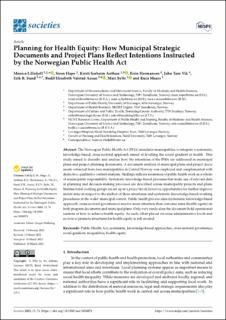| dc.contributor.author | Lillefjell, Monica | |
| dc.contributor.author | Hope, Siren | |
| dc.contributor.author | Anthun, Kirsti Sarheim | |
| dc.contributor.author | Hermansen, Eirin | |
| dc.contributor.author | Vik, John Tore | |
| dc.contributor.author | Sund, Erik Reidar | |
| dc.contributor.author | Aasan, Bodil Elisabeth Valstad | |
| dc.contributor.author | Sylte, Mari | |
| dc.contributor.author | Maass, Ruca Elisa Katrin | |
| dc.date.accessioned | 2023-11-08T13:31:16Z | |
| dc.date.available | 2023-11-08T13:31:16Z | |
| dc.date.created | 2023-03-27T22:06:50Z | |
| dc.date.issued | 2023 | |
| dc.identifier.citation | Societies. 2023, 13 (3), 74. | en_US |
| dc.identifier.issn | 2075-4698 | |
| dc.identifier.uri | https://hdl.handle.net/11250/3101447 | |
| dc.description.abstract | The Norwegian Public Health Act (PHA) mandates municipalities to integrate a systematic, knowledge-based, cross-sectoral approach aimed at levelling the social gradient in health. This study aimed to describe and analyse how the intentions of the PHA are addressed in municipal plans and project-planning documents. A document analysis of municipal plans and project documents extracted from four municipalities in Central Norway was employed and complemented with deductive, qualitative content analysis. Findings indicate awareness of public health work as a whole-of-municipality responsibility. Systematic knowledge-based processes that make use of relevant data in planning and decision-making processes are described across municipality projects and plans. Multisectoral working groups are set up at a project level; however, opportunities for further improvements arise in respect to the anchor of these structures and systematic knowledge-based working procedures in the wider municipal context. Public health process aims (systematic knowledge-based approach, cross-sectoral governance) receive more attention than outcome aims (health equity) in both program documents and municipal plans. Only very rarely does the document hold operationalizations of how to achieve health equity. As such, effort placed on cross-administrative levels and sectors to promote structures for health equity is still needed. | en_US |
| dc.language.iso | eng | en_US |
| dc.publisher | MDPI | en_US |
| dc.rights | Navngivelse 4.0 Internasjonal | * |
| dc.rights.uri | http://creativecommons.org/licenses/by/4.0/deed.no | * |
| dc.title | Planning for Health Equity: How Municipal Strategic Documents and Project Plans Reflect Intentions Instructed by the Norwegian Public Health Act. | en_US |
| dc.title.alternative | Planning for Health Equity: How Municipal Strategic Documents and Project Plans Reflect Intentions Instructed by the Norwegian Public Health Act. | en_US |
| dc.type | Peer reviewed | en_US |
| dc.type | Journal article | en_US |
| dc.description.version | publishedVersion | en_US |
| dc.rights.holder | © 2023 by the authors. Licensee MDPI, Basel, Switzerland. | en_US |
| dc.source.pagenumber | 15 | en_US |
| dc.source.volume | 13 | en_US |
| dc.source.journal | Societies | en_US |
| dc.source.issue | 3 | en_US |
| dc.identifier.doi | 10.3390/soc13030074 | |
| dc.identifier.cristin | 2137396 | |
| dc.relation.project | Norges forskningsråd: 302705 | en_US |
| dc.source.articlenumber | 74 | en_US |
| cristin.ispublished | true | |
| cristin.fulltext | original | |
| cristin.qualitycode | 1 | |

